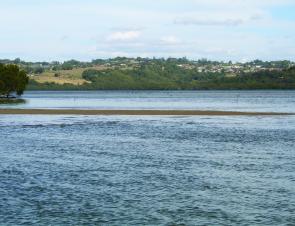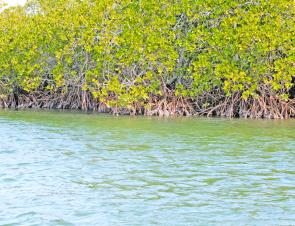With a new season of surface-luring in the bud, now’s the time for a refresher course.
SECTION: features
MAPS:
Facts
ILLUSTRATIONS: 0
The small surface stickbait was zigzagging towards the boat, sending ripples across the oil-smooth surface of the canal until they lapped the sandy beach. The bream sensed the activity and moved towards the lure, hoping for an easy meal.
The angler paused the lure, allowing some of the ripples to dissipate before resuming the ‘walk the dog’ retrieve. The first indication of the bream was a telltale bow wave appearing behind the lure.
The angler quickened his retrieve slightly to make the bream think that its prey was trying to escape and, as the bream closed on the lure, the angler stopped winding.
The pause had the desired effect and the lure disappeared below the surface after a loud sipping sound as the fish inhaled it.
A steady lift of the rod was all that was required to set the hooks. As it tore along beside the bank, the fish stripped line off the small threadline and the angler yelled out in sheer joy.
It’s hard to beat the sheer pleasure that surface luring for bream gives.
With the warming effect that Summer brings on our waterways, the bream generally become more active and casting surface lures becomes a very good method to target these wily fish.
As with any form of luring, knowing when to do what at the right time is the key to success.
There are many variations of topwater lures out there that catch bream but at times certain models outperform others.
The lure that caught you a few bream yesterday often fails to deliver the next time you head out – the trick is to work out why.
Breaking down the conditions you intend fishing into two categories can help when making the decision on which lure to tie on easier.
For the days when the surface looks like an oil slick, the right lure to fish with would be something that doesn’t cause too much disturbance. Bream can detect something on the surface from a fairly long way away in calm conditions and anything that appears unnatural to them will be shunned.
The slider or surface stick bait is the go-to lure in this situation.
One of the keys to fishing surface walkers is to cast them past the structure you want to fish.
This helps in two ways. Firstly, it gives the fish a chance to move to a position on the structure where it can ambush its prey and, secondly, if the fish is in a timid mood it won’t spook away as soon as the lure splashes down.
A trick we use on heavily fished waterways is to actually cast the lure on the sandy bank and then pull it into the water. This way the fish are not intimidated by the lure at all.
Once the lure has been cast, work the it up to the structure with a walk-the-dog retrieve (see fact box) and, as it draws level to the structure, let the lure sit motionless for a few seconds before resuming the retrieve.
This gives the bream the idea that its prey is resting for a second and stimulates the fish into striking.
This is where you need to pay special attention to how the bream reacts to your lure.
Quite often they are not in an aggressive mood and only boil on the lure without striking. You then have to adjust your retrieve to stimulate them into biting.
This could be by speeding up the lure as the bream closes on it, followed by a sudden pause. The bream will then literally run into the lure and have to eat it!
On another day you might have to leave the lure sitting motionless, with only the smallest of twitches to get the desired effect.
It is very much a trial-and-error method of fishing but, if you’re wearing polarised sunglasses, the bonus is that you can see the fish’s reactions to what you are doing with your lure.
There are many surface walkers gracing the tackle store shelves and we all have our favourites. I usually tie on a Lucky Craft Pencil first because it is a good, mid-sized lure and casts very well.
If I need to downsize due to timid bites or spooky fish then I use a Smith Towadi or a Jackson T-Pivot.
If I need to upsize to cast longer or to target larger bream, the Lucky Craft Sammy is my go-to lure.
If the water is disturbed by wind or wave action then a lure that puts out more noise becomes a better option.
Cup-faced poppers or fizzers can pull bream from a long way in choppy conditions and because of these conditions, the fish are generally a lot more aggressive. The waves oxygenate the water as well as offering the bream more cover than clear, glassy conditions.
Once again, it pays to mix up the retrieve a bit to find out what the bream want on the day.
A general rule is to match your retrieve to the amount of chop on the surface. The rougher it is, the more noise you need your lure to make.
Try using a constant popping retrieve with the odd pause thrown in. If the fish don’t connect to the lure then you need to lengthen the pauses or slow down the retrieve.
Poppers and fizzers generate disturbance straight from the start of the retrieve, unlike surface walkers that usually take up to a metre before they start zigzagging from side to side.
Again, lure choice is a personal preference but my favourite popper is the Lucky Craft Bevy Pop. It has great rattles and comes standard with a hackled rear treble.
When using a popper with feathers on the rear treble, apply scent on these feathers. If the bream are short striking your lure, the addition of scent can often tempt them into having another go.
The structure you fish can also dictate what type of lure you cast.
Wide, shallow flats require long casts and lures that can cover ground fairly quickly. In these instances a surface walker would be the gun lure.
Not many bream lures cast as well as the stickbaits and they can be worked fairly quickly back to the boat.
If you were casting tight to mangrove-lined banks then you would want a lure that will stay in the strike zone longer and be able to attract bream immediately after touching down.
For this scenario, a popper or fizzer would be hard to go past.
I believe that colour does play a role when casting topwaters, especially in clear water – but the results we achieve often go against popular beliefs.
We had a day on the Gold Coast canals where a bright yellow surface walker outperformed any other colour lure in crystal-clear water.
The only advice that I can give regarding colour is to start off with natural colours and if the bream seem to be refusing your lure at the last moment, then a change of lure colour might be the key.
One colour modification I do to all my surface lures is more for my convenience rather than as an extra attractant to the fish. I paint the nose of the lure a bright orange with a water-based paint.
Bream often smash a lure hard, with spray going everywhere. When this happens I don’t strike unless I am sure the lure is in the fish’s mouth.
This is very hard to see in all the commotion unless the part of the lure facing you is very visible. If I can’t see the bright orange nose then I wind down until I feel the weight and then lift the rod steadily.
Once the bream starts shaking its head, the hooks are in.
If the fish has missed the lure and you can still see it bobbing around and you can keep your cool, then carry on with the retrieve and hope the fish has another go.
These are some of the basic principles on surface luring for bream that I constantly find myself coming back to time and again when deciding on lure choice. Hopefully they get you that bit closer to pinning a few lure-munching bream on the surface.
Facts
Tackle Author’s Choice
Rods
1-3kg or 2-4kg spin rodG.Loomis DSR 8200
Reels
Size 1000-2500 spin reelDaiwa Sol 2000
Braid
As light as possible to aid casting small lures 10lb Castaway or 6lb Rock Fish PE
Leader
4lb to 8lb fluorocarbon Sunline V Hard or FC Rock
Facts
Walking the dog
This popular a retrieve causes the lure to dance from side to side as it is worked back towards the boat.
It is initiated by small downward strokes of the rod tip, coupled with a constant winding of the reel.
The trick is to stab the rod on the momentary times when the braid is slack. This is what causes the darting, zigzag action.
Once the lure starts this sideways cadence, it simply becomes a case of flicking the rod tip in consistent timing to coincide with the lure’s movements.

Shallow flats are great places to start chasing bream on topwaters. As the tide runs in the bream move back up into the shallows to feed.

Poppers are the go for targeting bream on mangrove lined banks like this. The lures need to be cast right up at the base of the roots and kept in the strike zone for as long as possible




